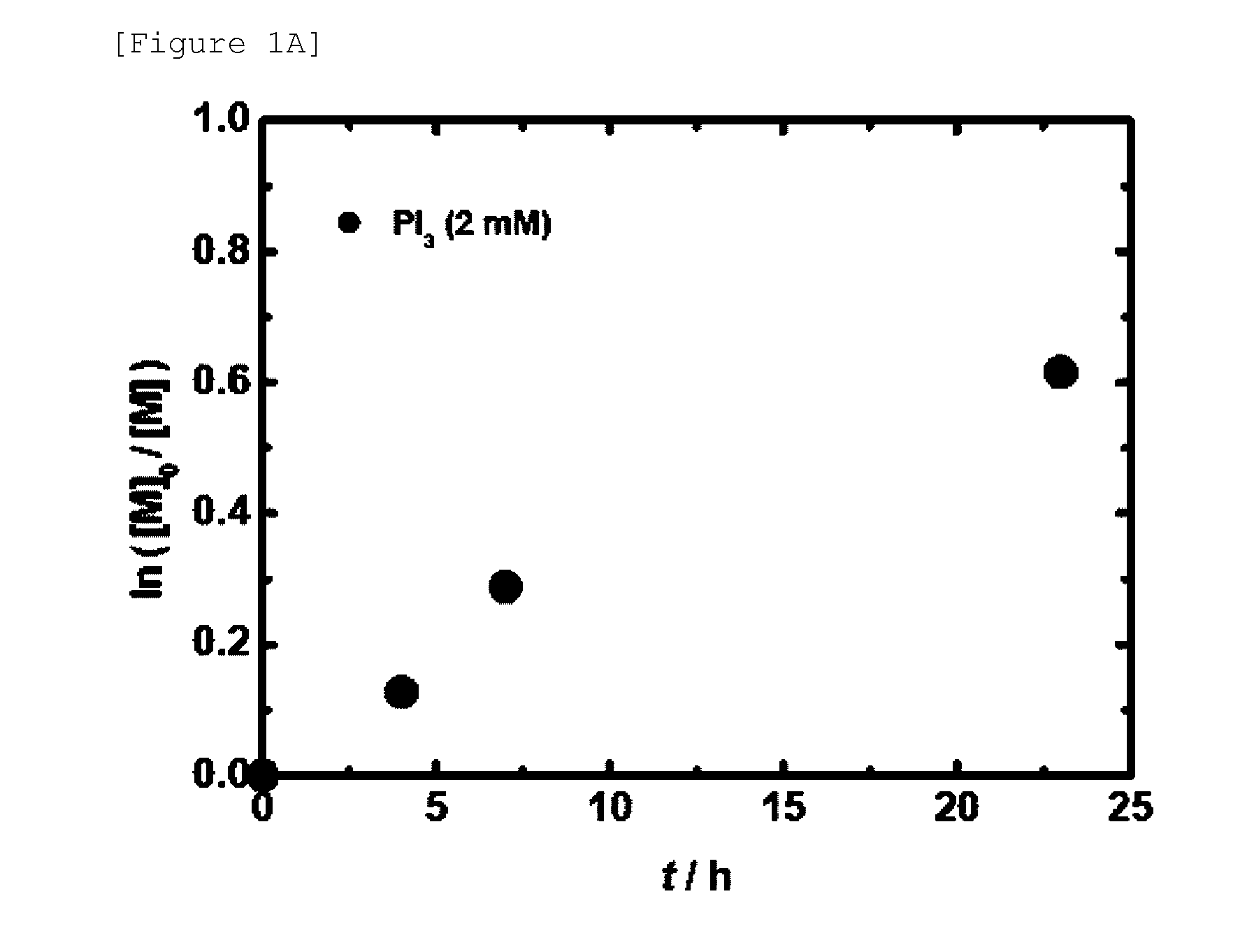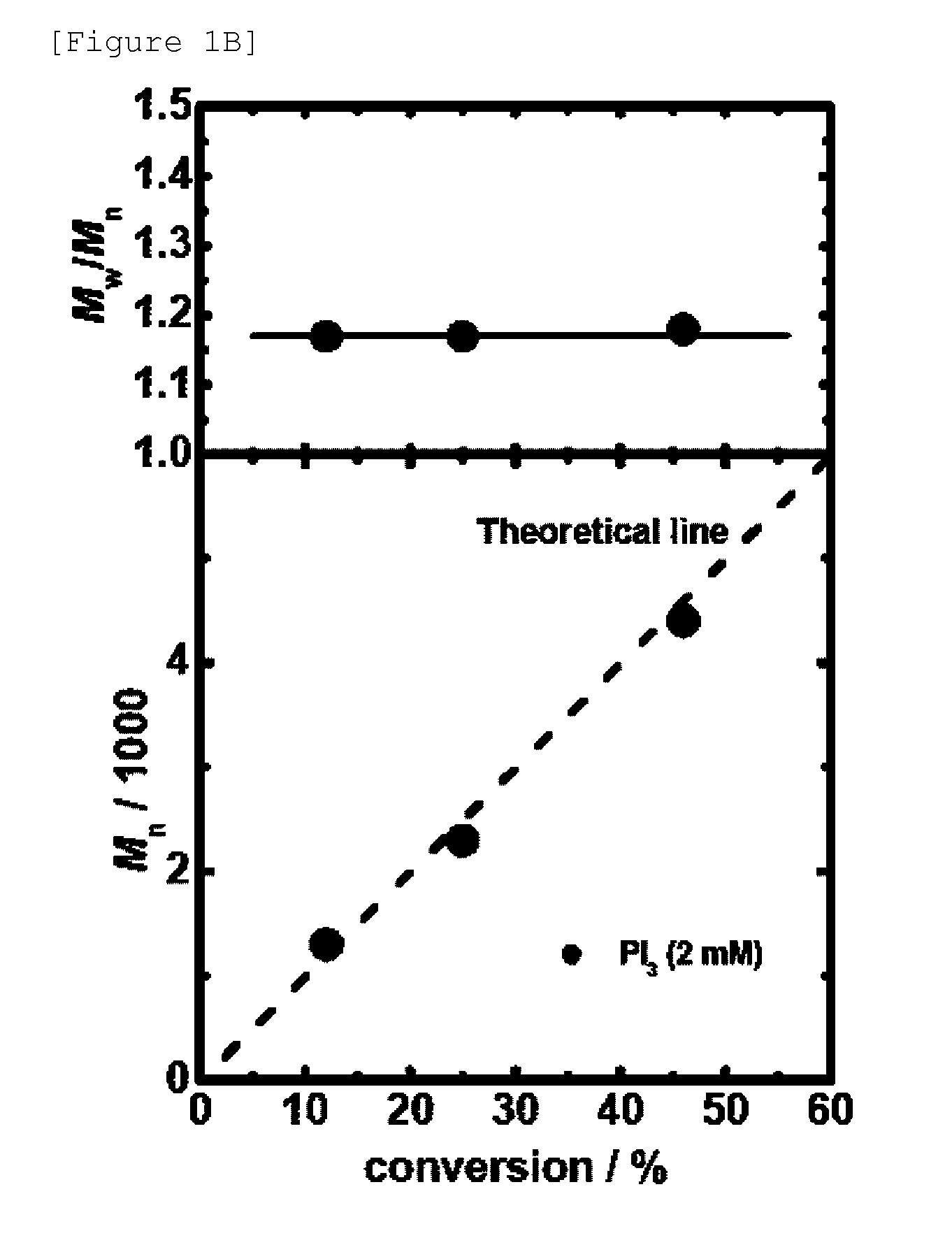Novel living radical polymerization method using a phosphorus compound or nitrogen compound as a catalyst
- Summary
- Abstract
- Description
- Claims
- Application Information
AI Technical Summary
Benefits of technology
Problems solved by technology
Method used
Image
Examples
example 2
Bulk Polymerizations of Styrene (St) with Two Different Phosphorus Hydrides R2PH(═O) (Catalysts)
[0237]Polymerization of styrene was carried out using the reaction materials and reaction conditions as shown in Table 2 (entries 1 to 6).
[0238]In a system similar to Example 1, instead of PI3, R2PH(═O), which is a hydride of a phosphorus compound, was used as a precursor of a catalyst (aforementioned scheme 2). In this polymerization, due to cleavage of DCP (peroxide), an alkoxy radical is generated (aforementioned scheme 2a). The alkoxy radical abstracts a hydrogen from R2PH(═O) to generate the phosphorus radical R2P(═O) (aforementioned scheme 2b). The phosphorus radical works as an activator of polymer-I, achieving the reversible activation (aforementioned scheme 2c).
[0239]In this Example, as a catalyst, (BuO)2PH(═O) and (EtO) PhPH(═O) were used for polymerization of styrene. Further, in Example 5, which is described later, (EtO)2PH(═O) and (iPrO)2PH(═O) were used in polymerization of ...
example 3
Bulk Polymerizations of Styrene(St) with N-iodosuccinimide (NIS) (Catalyst), Two Different Alkyl Iodides, and Two Different Radical Initiators, at Two Different Temperatures
[0241]Similarly to Example 1, but instead of PI3 (as a catalyst), bulk polymerizations of styrene (St) were carried out with a nitrogen iodide, N-iodosuccinimide (NIS: the chemical formula is shown above), as a catalyst (Table 3 and FIGS. 3A and 3B). The polymerization mechanism for NIS is the same as that for PI3 (Example 1). Low-polydispersity polymers were obtained with PE-I as an alkyl iodide and 2,2′-azobis(2,4,4-trimethylpentane) (VR110) as a radical initiator at 100° C. (Table 3, entry 1 and FIGS. 3A and 3B). Low polydispersity was also achieved by using a different radical initiator, benzoyl peroxide (BPO), at a different temperature, 80° C. (Table 3, entry 2). Further, low polydispersity was also achieved by using a different alkyl iodide, iodoform (CHI3), and a different radical initiator, benzoyl perox...
example 5
Bulk Polymerizations of Methyl Methacrylate (MMA) with R2PH(═O) (Catalyst)
[0245]Similarly to Example 4, bulk polymerizations of MMA were carried out, with the proviso that instead of PI3 (Example 4), a phosphorus hydride compound R2PH(═O) was used as a catalyst (a precursor of catalyst) (Table 5 and FIGS. 5A and 5B). The polymerization mechanism is the same as the mechanism for the styrene polymerization with R2PH(═O) (Example 2). 2-cyanopropyl iodide (CP-I), benzoyl peroxide (BPO), and (EtO)2PH(═O) were used as an alkyl iodide, a radical initiator, and a catalyst (precursor), respectively, and polymerizations were carried out at 70° C. With 20 mM of (EtO)2PH(═O), polymers having low polydispersities were obtained (Table 5, entry 1 and FIGS. 5A and B). Even with a lower concentration (10 mM) of (EtO)2PH(═O), a low polydispersity was achieved (Table 5, entry 2). With a lower concentration of CP-I, polymers having higher molecular weights and low polydispersities were obtained (Table ...
PUM
| Property | Measurement | Unit |
|---|---|---|
| Time | aaaaa | aaaaa |
| Time | aaaaa | aaaaa |
| Time | aaaaa | aaaaa |
Abstract
Description
Claims
Application Information
 Login to View More
Login to View More - R&D
- Intellectual Property
- Life Sciences
- Materials
- Tech Scout
- Unparalleled Data Quality
- Higher Quality Content
- 60% Fewer Hallucinations
Browse by: Latest US Patents, China's latest patents, Technical Efficacy Thesaurus, Application Domain, Technology Topic, Popular Technical Reports.
© 2025 PatSnap. All rights reserved.Legal|Privacy policy|Modern Slavery Act Transparency Statement|Sitemap|About US| Contact US: help@patsnap.com



